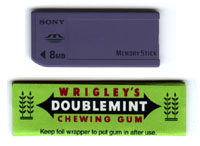Sony DSC-S70 Digital Camera
by Matthew Witheiler on October 18, 2000 12:00 PM EST- Posted in
- Digital Camera
Storage
In order to move Sony cameras into the 21st century it was necessary to abandon the floppy disk storage method and move to something with more space and a smaller footprint. Rather than follow the path nearly every other digital camera manufacturer has taken, Sony chose to stray from the compact flash/smart media route and use a technology already developed in-house: the Sony Memory Stick.
The history of the Memory Stick is short, with Sony releasing it as a solid state storage option about a year and a half ago. The Memory Stick is one of the physically smallest storage methods we have seen to date. As its name suggests, the Memory Stick is smaller than a stick of gum and extremely light. The S70 is not the only Sony product to use this storage method, rather all Cybershot cameras as well as Sony's MP3 player use this technology as their primary storage method.
Although the technology is interesting, there is more than one downfall to using the Memory Stick. Unfortunately, the first downfall is not a result of the Memory stick itself but rather the one that is included in the DSC-S70 package. With 64MB and 32MB sizes already available and a 128MB Memory Stick on the way, it is unacceptable and almost insulting that Sony includes a measly 8MB Memory Stick with the S70. Barely enough to hold six 2048x1536 JPEG images (the largest size picture that the S70 can produce), the included 8MB stick can not even store one full sized (2048x1536) tiff file. Sony may have just as well left out the 8MB Memory Stick and discounted the already pricey S70. Essentially every person who is pricing the S70 should go ahead and add at least $100 to the camera's price to cover a 64MB Memory Stick, as without it the camera's functionality is severely limited. Sony should be ashamed of themselves for forcing DSC-S70 owners to buy an additional Sony product.
The aforementioned problem could easily be fixed by Sony with the packaging of a higher capacity Memory Stick with the S70, however other Memory Stick specific problems are harder to fix. First, the access time on the Memory Stick in our S70 seemed sluggish, requiring a whopping 4 seconds to switch from file to file (at 2048x1536 JPEG) in playback mode.
Secondly, the Sony Memory Stick is a proprietary Sony format, a quality that normally scares us away. First off, with no products but Sony products using the Memory Stick format, price is set by Sony and Sony alone. There is and will not be any competition in the Memory Stick market to force prices down. Then there is the fact that Memory Stick technology is still relatively new. We are yet to see if the technology will be used in other manufacturer's processes or even to see how dedicated Sony is to the project. If support becomes poor, Memory Stick updates to more memory may never come, leaving the user with a very limited amount of upgrade options. We would feel much safer if the support base for the Sony Memory Stick was as large as the base for Compact Flash cards.
Data from the Memory Stick can get to one's computer via a few different options, only one of which comes with the DSC-S70 package. The included transfer mode is via a USB connection that plugs directly into the camera body. After a simple driver install, plugging the USB cable into one's computer causes the camera to act as a removable storage device, coming up as a drive in Windows. The interface is not overly elaborate and gets the job done in a fairly simply way.
For those out there wanting different transfer methods, you are in luck. Sony has a variety of Memory Stick reader options. One can get an extremely slow floppy disk adapter (where the memory stick actually plugs into a 3.5 inch floppy), a fast PCMCIA adapter, or even a parallel port reader. For many users, the built-in USB connection will prove to be the most useful, making the other modes of transport unnecessary.














0 Comments
View All Comments